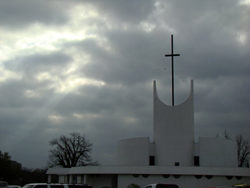Editor's note: This is the latest in a series of stories about congregations responding to the Presbyterian Church (U.S.A.)'s call to "Grow Christ's Church Deep and Wide." The call to grow in evangelism, discipleship, servanthood and diversity was adopted by the 2008 General Assembly and renewed by the 2010 General Assembly. — Jerry L. Van Marter
Jesus taught that the church is to minister to the outsider, the stranger, the leper, but it can be easy to forget that.
But St. Paul's Presbyterian Church in San Angelo, Texas, does more than just remember this lesson — it has a long tradition of offering a church home to those who might not feel welcome anywhere else.
"Our history of diversity and inclusivity goes back to the 1950s," said co-pastor the Rev. Glenda Harbert. She added that the church helped a local woman of Navajo and black descent set up a preschool.
"That's pretty unusual for a white church in west Texas in the 1950s," said Harbert's co-pastor, the Rev. Timothy Davenport-Herbst. "Today we are one of less than a dozen multicultural congregations in the PC(USA) with over 500 members."

St. Paul’s celebrates and encourages diversity in all its ministries, including youth group and Sunday school.
In perhaps another nod to being different, St. Paul's has used a co-pastor model for more than 20 years. Both pastors say this system has worked well.
"We both participate in every area, mission, youth, everything," Harbert said.
Over the years since that initial outreach, St. Paul's has continued to reach out to the lost.
"They have a long tradition of helping refugee populations settle here," said the Rev. Jose Luis Casal, general missioner of Tres Rios Presbytery, of which St. Paul’s is a member.
In the early 1980s, the church helped Laotian refugees settle in the area. Many of those people are still involved in the church.
"This congregation is the best example of a multicultural, multigenerational church that demonstrates real inclusivity," Casal said. "It's not just cultures — it's people who are different in many ways, people with disabilities and of different colors and races. They have white members and Hispanic members, Asian, and African-American. They are open to everyone, gay and lesbian and all social levels. They have upper middle class members right down to the homeless."
St. Paul's youth also display this inclusivity.
Davenport-Herbst has two autistic children, and said that 15 percent of the youth group is also autistic.
It's important to note that members are not just welcome but are fully included.

All are welcome at St. Pauls, where people feel comfortable expressing themselves, as this member did on Fat Sunday.
"There's an expectation here. We expect everyone to be included and we expect people to welcome them, but we also expect them to participate and do what others can, Davenport-Herbst said. “For example, we have some children with speech impediments but they still speak in worship."
St. Paul's, which has about 620 members, has grown during the past 40 years because people who didn't feel wanted elsewhere have sought out the church. Word continues to go out among new members.
"People feel comfortable here," Harbert said. "We have many members who are fighting addictions, have relationship problems, learning disabilities, autism, and some who are poor. We have doctors and lawyers and nurses along with probationers, the homeless and the disabled. But it makes our members more mission-minded to reach out to others, especially those who can identify because they have been there themselves, and that allows us to make tremendous strides in helping the community."

Two friends at St. Paul’s celebrate Martin Luther King Jr. Day.
The makeup of the congregation leads to an interesting mix in worship on Sunday morning. Davenport-Herbst recalled looking around the Communion table one week and seeing known drug dealers sitting across from the same people who work to lock them away.
"We will make room for those who are different," Davenport-Herbst says. "The space for God's grace and God to work within the congregation allows for these things."
The key is to make church a place of God instead of an exclusive club.
"This is a real example of what is the church of Jesus Christ," Casal said. "It's more than just multicultural and multiethnic."
Toni Montgomery is a freelance writer in Statesville, N.C., where she also serves as church secretary for First Presbyterian Church.

